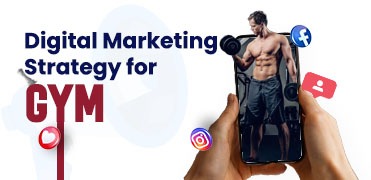Digital marketing strategy for GYM
The digital landscape has become the ultimate battleground for any industry seeking to thrive and stand out. A robust digital marketing strategy is not just an option, it's a necessity for gyms aiming to attract, engage, and retain members effectively. The fitness industry is booming, and gyms need to leverage the power of digital marketing to stay ahead of the curve.
- .
- Wom
- .
- April 19, 2024

Introduction to Digital Marketing Strategy for Gyms
The digital landscape has become the ultimate battleground for any industry seeking to thrive and stand out. A robust digital marketing strategy is not just an option, it's a necessity for gyms aiming to attract, engage, and retain members effectively. The fitness industry is booming, and gyms need to leverage the power of digital marketing to stay ahead of the curve.
-
Importance of Digital Marketing in the Fitness Industry
The fitness industry is highly competitive, with numerous gyms contending for the attention of health-conscious consumers. Digital marketing provides a cost-effective means to stand out in this crowded space, enabling gyms to reach their target audience with precision and impact.
In this digital age, potential members research gyms online before stepping through the door. A strong digital marketing strategy allows you to showcase your state-of-the-art facilities, diverse group fitness programs, and expert trainers, giving you a competitive edge.
You can target potential members with relevant messaging based on their location and interests, making it easier for them to discover your gym and the value you offer.
-
Objectives of the Digital Marketing Strategy
Before diving into the specifics, it is essential define your SMART goals (Specific, Measurable, Achievable, Relevant, and Time-bound).
Do you want to boost memberships by 20% in the next quarter? Increase social media engagement by 50% within six months? Drive website traffic by 10% each month? Having clear objectives will guide your digital marketing efforts and help you measure success.
-
Understanding the Target Audience
To tailor your marketing campaigns effectively, it's crucial to understand your target audience. This involves analyzing demographics such as age, gender, and location, as well as psychographics like lifestyle, interests, and behaviors. Identifying their pain points and challenges will further inform your strategies.
-
Demographics (Age, Gender, Location)
Knowing your ideal member is key. Consider age groups you cater to, their gender breakdown, and the geographical area you serve. This information will inform your content creation and advertising strategies. For example, if your gym boasts a wide range of family-friendly amenities, you might target parents with young children through social media ads.
-
Psychographics (Lifestyle, Interests, Behaviors)
Dig deeper than demographics. What are your target audience's fitness goals? Do they prefer High-Intensity Interval Training (HIIT) or yoga classes? Are they social butterflies who thrive in group settings, or do they prefer a more personalized approach? What kind of content resonates with them?
Understanding their interests and behaviors allows you to tailor your messaging. Let's say your gym offers a variety of weight-loss programs. You can create blog posts with meal plans and healthy recipe ideas to target people interested in nutrition and weight management.
-
Pain Points and Challenges
What are the common obstacles people face when starting or maintaining a fitness routine? Do they lack motivation, struggle with meal planning, or feel intimidated by a gym environment?
Identify the specific pain points and challenges that your target audience faces in their fitness journey. Addressing these pain points will resonate deeply with potential members and drive conversions.
Addressing these pain points in your marketing will position your gym as the solution. You can develop motivational content, offer consultations with on-site nutritionists, and highlight your welcoming and supportive community to overcome these challenges.
-
Setting Clear Goals and Key Performance Indicators (KPIs)
Setting specific, measurable goals and KPIs is essential for tracking the success of your digital marketing initiatives.
Whether it's increasing membership sign-ups, improving website traffic, or enhancing brand recognition, having quantifiable metrics in place will guide your efforts.
-
Increase Membership Sign-ups
Increase Membership Sign-ups is a primary objective for most gyms. Track the number of online sign-ups, phone call inquiries generated from your website, and free trial class registrations to measure success.
-
Boost Engagement on Social Media Platforms
High follower engagement demonstrates a thriving online community. Track metrics like likes, comments, shares, click-through rates, and reach to gauge social media effectiveness. Consider running contests or polls to encourage interaction and brand loyalty.
-
Drive Traffic to the Gym's Website
Monitor website traffic sources (organic search, social media referrals, paid advertising), analyze visitor behavior through heatmaps and session recordings, and track conversions (e.g., booking a class or contacting the gym) to understand how users interact with your website.
-
Improve Brand Awareness and Recognition
A strong online presence builds brand recognition. Track brand mentions on social media and review platforms, monitor your social media reach, and analyze website traffic sources to measure how recognizable your gym is within your target market.
-
Website Optimization for Conversion
Your gym's website serves as the digital storefront, and optimizing it for conversion is essential. This entails ensuring a responsive design for seamless user experience, incorporating clear call-to-actions (CTAs), implementing online booking and membership registration functionalities, and employing effective SEO strategies to improve visibility.
-
Responsive Design and User Experience
Your website should be accessible and visually appealing across all devices (desktop, mobile, tablet). Ensure a seamless user experience with clear navigation, fast loading times, and high-quality visuals showcasing your gym's facilities and offerings.
-
Clear Call-to-Actions (CTAs)
Tell your website visitors what you want them to do next. Use strong CTAs throughout your website, such as "Join Now," "Book a Free Trial," or "Download Your Free Workout Guide." Make your CTAs prominent and easy to find, directing users toward valuable actions.
-
Incorporating Online Booking and Membership Registration
Simplify the signup process by offering online booking for classes and online membership registration. Streamline the user journey by making it easy for potential members to join your gym from the comfort of their homes.
-
Search Engine Optimization (SEO) Strategies
Implement SEO best practices to improve your website's ranking in search engine results pages (SERPs). Conduct keyword research to identify terms people use to search for gyms in your area, and optimize your website content and meta descriptions with those keywords. This will increase your organic website traffic from potential members actively looking for gyms.
Content marketing plays a vital role in engaging and educating your audience. Crafting a compelling content marketing strategy is essential for gyms.
Blogging about fitness tips, workouts, and nutrition, creating engaging videos of workouts and training sessions, sharing success stories and testimonials, and leveraging user-generated content help to foster community.
-
Blogging About Fitness Tips, Workouts, and Nutrition
Become a trusted source of information by creating valuable and informative blog content. Share workout routines, healthy recipe ideas, and expert fitness tips to educate and inspire your audience. This establishes your gym's expertise and positions you as a go-to resource for all things fitness.
-
Creating Engaging Videos of Workouts and Training Sessions
Video content is highly engaging and easily digestible. Showcase your trainers, group fitness classes, and workout routines through high-quality videos. Share them on your website and social media platforms to give potential members a glimpse into the dynamic and energizing atmosphere of your gym.
-
Sharing Success Stories and Testimonials
Let your existing members be your brand ambassadors! Feature success stories and testimonials on your website and social media. Showcasing real people achieving their fitness goals with your guidance builds trust and motivates potential members to join your gym.
-
Utilizing User-Generated Content
Encourage your members to share their fitness journeys and experiences at your gym on social media using a specific hashtag. UGC adds a touch of authenticity and fosters a sense of community, further promoting your gym and attracting new members.
Social media platforms offer unparalleled opportunities for gyms to connect with their audience. Choose the right platforms based on your target demographic, create and share visually compelling content, run targeted advertising campaigns, and actively engage with followers to cultivate a thriving online community and amplify their brand presence.
-
Choosing the Right Social Media Platforms
Identify the platforms where your target audience spends the most time and establish a strong presence on these platforms.
Consider Facebook for a broader reach, Instagram for a visually-driven approach, and Twitter for real-time updates and discussions.
-
Creating and Sharing Visual Content
People are drawn to visually appealing content. Share high-quality photos and videos showcasing your gym's facilities, group fitness classes, and success stories.
Utilize infographics to present health and fitness information in an engaging way and drive engagement on social media.
-
Running Targeted Advertising Campaigns
Leverage social media advertising platforms to target your ideal members with precision and drive conversions. You can tailor your ads based on demographics, interests, and behaviors, maximizing your reach and return on investment (ROI).
-
Engaging with Followers and Encouraging User-Generated Content
Social media is a two-way street requiring meaningful interactions with your audience by actively engaging with followers.
Respond to comments and messages promptly, participate in relevant conversations, and run contests or polls to encourage interaction. This fosters a sense of community and keeps your audience engaged.
-
Email Marketing Campaigns
Email marketing remains a powerful tool for nurturing leads, fostering customer loyalty, and driving conversions.
Build an email subscriber list, send regular newsletters with valuable content and promotions, personalize emails based on subscriber preferences, and implement automated workflows for maximum efficiency.
-
Building an Email Subscriber List
Grow your email list by offering valuable incentives for signups, such as downloadable workout guides, healthy recipe ebooks, or exclusive discounts.
Include signup forms on your website, social media pages, and even offer in-gym signups with enticing offers.
-
Sending Regular Newsletters with Fitness Tips, Updates, and Promotions
Provide value to your subscribers with informative email newsletters. Share fitness tips, workout routines, healthy recipes, and upcoming events or promotions at your gym.
Segment your email list to send targeted content based on subscriber interests (e.g., weight loss, strength training) for increased engagement.
-
Personalizing Emails Based on Subscriber Preferences and Interactions
Personalization goes a long way. Use subscriber data (name, location, gym membership type) to personalize email greetings, content recommendations, and special offers.
This fosters a connection with your subscribers and makes them feel valued due to personalized content based on subscriber preferences, behavior, and interactions.
-
Implementing Automated Email Workflows (Welcome Series, Abandoned Cart Emails)
Streamline your email marketing efforts and nurture leads effectively. Automate email workflows to nurture leads and improve conversions. Send a welcome series to new subscribers introducing them to your gym, its offerings, and valuable resources.
Utilize abandoned cart emails to remind potential members who have started the membership signup process but haven't completed it.
-
Influencer Partnerships and Collaborations
Partnering with fitness influencers can amplify your gym's reach, credibility, and brand awareness.
Identify relevant influencers, negotiate partnerships for sponsored content and endorsements, and leverage their audiences to attract new members to your gym.
-
Identifying Fitness Influencers and Micro-Influencers
Partner with fitness influencers or micro-influencers whose target audience aligns with your gym's ideal member.
Identify relevant fitness influencers and micro-influencers whose values, audience, and content align with your gym's brand and target audience and have a strong local following.
-
Negotiating Partnerships for Sponsored Content and Endorsements
Forge mutually beneficial partnerships with influencers. Collaborate with influencers on sponsored content creation or social media endorsements.
Influencers can create workout videos showcasing your gym's facilities, share their positive experiences, or host contests and giveaways to promote your gym to their audience.
-
Leveraging Influencer Audiences to Reach New Potential Members
Influencer marketing allows you to tap into a pre-established and engaged audience. Utilize the influence and reach of influencers to expand your gym's audience, attract new potential members, and foster community engagement.
By collaborating with trusted influencers, you can reach a wider audience, build brand awareness, and attract potential members who follow the influencer's recommendations.
-
Paid Advertising Strategies
Paid advertising allows gyms to target specific demographics with precision. Utilize platforms like Google Ads and social media ads to reach your target audience, employ geo-targeted advertising for local outreach, and continuously monitor and optimize ad performance for maximum ROI.
Paid advertising offers gyms a powerful means to reach their target audience with precision and drive conversions. Let's explore the key strategies for effective paid advertising campaigns.
-
Google Ads (Search, Display, Remarketing)
Run targeted Google Ads campaigns to reach potential members actively searching for gyms or fitness-related services in your area.
Utilize search ads to appear on relevant keyword searches, display ads on high-traffic websites frequented by your target audience, and remarketing ads to remind website visitors who haven't converted yet.
-
Social Media Ads (Facebook Ads, Instagram Ads, LinkedIn Ads)
Take advantage of social media advertising platforms such as Facebook Ads, Instagram Ads, and LinkedIn Ads to target your ideal members with precision focus. You can tailor your ads based on demographics, interests, and behaviors, maximizing your reach and return on investment (ROI).
Consider running lead generation ads to capture contact information from potential members interested in learning more about your gym.
-
Geo-Targeted Advertising for Local Outreach
Maximize your reach within your local market. Utilize geo-targeting options with online advertising platforms to ensure your ads are shown to users within your gym's service area.
This allows you to focus your marketing efforts on potential members who are most likely to visit your gym.
-
Monitoring and Optimizing Ad Performance
Continuously monitor and optimize your advertising campaigns to maximize ROI, refine targeting, and improve ad performance over time by adjusting targeting parameters, ad creatives, and budgets to maximize your Return On Ad Spend (ROAS).
Track the performance of your paid advertising campaigns closely. Analyze metrics like clicks, impressions, conversions, and cost-per-acquisition (CPA) to identify what's working and what's not.
-
Monitoring and Analytics
Data-driven decision-making is crucial in digital marketing success. Tracking key metrics and analyzing data is essential for refining your digital marketing strategies over time.
Utilize tools like Google Analytics and social media insights to monitor website traffic, conversion rates, and social media engagement, and make data-driven decisions for continuous improvement.
-
Tracking Key Metrics (Website Traffic, Conversion Rates, Social Media Engagement)
Regularly monitor key metrics to measure the success of your digital marketing efforts. Track website traffic sources, conversion rates (e.g., online membership signups), and social media engagement metrics (likes, comments, shares) to understand how users interact with your online presence.
-
Utilizing Google Analytics and Social Media Insights
Free analytics tools like Google Analytics and social media insights platforms provide valuable data. Use them to gain insights into user behavior, content performance, and audience demographics.
This data will inform future marketing strategies and help you refine your approach for continuous improvement and make informed decisions.
-
Making Data-Driven Decisions for Continuous Improvement
Digital marketing is an ongoing process. By tracking key metrics and utilizing analytics tools, you can make data-driven decisions to optimize your campaigns.
Regularly test different strategies, analyze the results, and adapt your approach based on what works best for your gym and help you allocate resources effectively.
-
Budgeting and Resource Allocation
Effective budgeting and resource allocation are critical for maximizing the impact of your digital marketing efforts. Allocate your budget across different marketing channels based on performance and goals, determine ROI for each campaign, and adjust budgets accordingly to optimize results.
Effective budgeting and resource allocation are critical for maximizing the impact of your digital marketing efforts. Let's explore the key considerations and strategies for budgeting and resource allocation.
-
Allocating Budget Across Different Marketing Channels
Develop a realistic and optimal allocation of your marketing budget that aligns with your gym's financial goals.
Allocate funds strategically across different marketing channels based on their potential return on investment (ROI). Consider factors like historical campaign performance, target audience behavior, and industry trends when determining budget allocation.
-
Determining ROI for Each Marketing Campaign
Track the return on investment (ROI) of each marketing campaign to understand which strategies are generating the most leads and memberships.
Analyze metrics like cost per acquisition (CPA) and customer lifetime value (CLTV) to determine the profitability of your marketing efforts.
By measuring ROI, you can identify areas for optimization and ensure you're investing your marketing budget wisely.
-
Adjusting Budgets Based on Performance and Goals
Your marketing budget shouldn't be static. Continuously monitor campaign performance and adjust your budget allocation based on the results.
Invest more in channels that deliver strong ROI and scale back on those that aren't performing as well. This ensures your marketing budget is working effectively to achieve your gym's overall goals.
-
Conclusion and Future Outlook
By implementing a strategic approach that encompasses website optimization, content marketing, social media engagement, and paid advertising, gyms can effectively reach their target audience, drive engagement, and ultimately grow their business. Continuous monitoring, analysis, and adaptation will ensure sustained success and future growth in the ever-evolving digital realm.
-
Summary of the Digital Marketing Strategy
Summarize the key components and strategies outlined in your gym's digital marketing blueprint, emphasizing the importance of an integrated and holistic approach to achieving marketing success.
By implementing the strategies outlined above, you can build a strong online presence, attract new members, and achieve your business objectives. A successful digital marketing strategy is an ongoing process.
-
Evaluation of Success and Lessons Learned
Regularly evaluate the effectiveness of your digital marketing efforts. Track key performance indicators (KPIs), analyze campaign performance data, and solicit feedback from your audience. This will help you identify areas of success, learn from mistakes, and refine your approach over time for improvement to inform future strategies and tactics.
-
Future Plans for Scaling and Growing the Gym's Online Presence
As your gym's online presence grows, explore new tactics to stay ahead of the curve. Outline your gym's future plans and aspirations for scaling and expanding its online presence, including innovative marketing initiatives, new channels, and strategic partnerships to fuel continued growth and success.
Additionally, stay informed about the latest digital marketing trends and adapt your strategy accordingly to maintain a competitive edge.




